In 2022, there are several ways to make money with print on demand with little to no investment involved from your end. In the last five years, I have used print-on-demand services to make a full-time income while travelling the world.
At the end of the article, you will have a thorough insight into the workings of the industry, how much money you could make with print-on-demand and also steps to design a best-selling artwork. But, before we get into the nitty-gritty of it all, let me answer your burning question:
Is Print-On-Demand Worth It in 2022?
The quick answer is – YES! Earning money with print-on-demand is possible and can be highly profitable, even in 2022. The economic crisis, inflation, and war in Ukraine — have affected multiple industries, including e-commerce. But you need to diversify your sources of income now more than ever. Relying on just the salary from your job or your business to earn a living is not ideal. Passively generating money with print-on-demand (POD) is always a good idea.
Also, fresh sellers with new designs take a few weeks and sometimes even months to trend on POD marketplaces. So even if people are currently holding back on spending money, you will want to have your online shops ready for when buyers are looking to splurge, especially during the holiday season of November & December.
IN THIS ARTICLE:
So, What Exactly Is Print-On-Demand?
Print-on-demand (POD) is a method where products like t-shirts, art prints, mugs, phone cases, dresses, and tote bags are designed and sold on a per-order basis. When a buyer makes a purchase, the design is printed especially for them.
Do you know the best part about the print-on-demand business (besides the passive income)? There are no upfront print costs to get started. In addition, you don’t need a warehouse full of items collecting dust and waiting to get sold. And most print-on-demand services provide fulfilment and shipping. What that means for you is you can make an income with just a laptop, wifi and creative ideas, making it a perfect income stream for digital nomads in 2022.
How to Make Money With Print-On-Demand
To make money with POD, you should create original trendy artworks that look great on products and upload them to print-on-demand platforms or marketplaces. The company you upload your artwork to takes a big cut for production and fulfilment, while you make money as royalties from each sale.
How Much Can You Make With Print-On-Demand?
On average, you will make between 1 USD – 40$USD in royalties for every item sold. It’s a pretty wide range – I know. But, the exact amount depends on the marketplace, category of product and the profit margin you’ve set for it.
Pros Of Print-On-Demand
- No up-front costs
- No shipping headache
- Free marketing
- Passive income that makes you money while you sleep
- Any creative in any country can set up a POD store
Cons Of Print-On-Demand
- Quality of the products
Not all products on every POD site are printed and shipped with complete perfection. You can’t be there to quality check each item before they are dispatched.
- Volatile Source of Income
The uncertainty of the print-on-demand world makes it a scary option for some. The websites making you a full-time income could suddenly go out of commission. To avoid this, don’t put all your eggs in one basket. Have not only multiple print-on-demand stores on different websites, but also diversify your passive income stream.
- Low Royalty Rates
Most websites allow you to set your royalty rates for every product category. You can charge as much as 100% of the original price for each item.
A structure like this is easily profitable for things with low production costs like stickers and small art prints, but your designs would have to be truly unique and trendy for users to pay x10 the price for other products.
Best Print-On-Demand Sites to Make Money
The list below covers the masters in the POD world. There are several others like Displate, Merch By Amazon*, Threadless and Zazzle, but for this article, we’ll focus on the five listed below, which, in my experience, have been the best all-around.
Note: Merch By Amazon (MBA) is a platform with the largest audience of all POD sites, but getting an invite or being approved for a store is a challenge. My advice would be to create stores on other platforms to gain experience and only then apply for an MBA account.
1. Redbubble

For me, Redbubble has been the most profitable of all print-on-demand websites as a photographer and digital artist. I set up my profile and sold my first design in 2018. By 2019 I was making 500$USD a month — this income quadrupled in 2020. Strangely enough, the beginning of the COVID-19 pandemic was the best financial period for me.
With only 100 designs, I earned more with Print-on-demand than in my day job as a freelance graphic designer. Let’s dive deep into Redbubble – the POD giant.
Pros Of Redbubble
- Killer Marketing Strategies
Redbubble is the KING of successful marketing in the print-on-demand universe. They regularly work with influencers to highlight the site’s best-selling products. When the influencers share photos of themselves using these products, Redbubble sales get a massive boost.
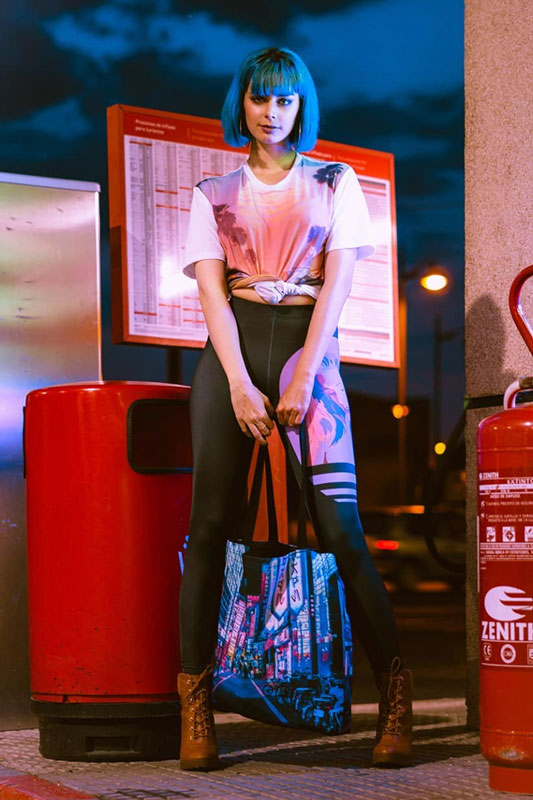
- SEO optimised pages
Good SEO changes everything, and Redbubble knows it. When you google the phrase “funny tee shirt with the text”, the first search result is products available from Redbubble.
So, if your designs are of high quality and contain the right keywords in the title and description, your listing will receive an audience that’s ready to make a purchase.
You don’t need to have 40k followers on Instagram to be successful on Redbubble, they market your products for you.
- Wide Range of Quality Products
Redbubble updates its product library often to keep up with the rising demands. They were the first ones to add masks in 2020. What’s more, they’ve recently added mouse pads and pet products which have been selling like crazy.
Cons Of Redbubble
- Average Quality Check
Unfortunately, sometimes my buyers message me to tell me that the products they received had misaligned artwork. In a few cases, their item arrived folded and usable.
Once, a customer even got cheap sunglasses in their mail from Redbubble instead of the tote they ordered! Errors like these put consumers off and makes them think twice before using RB again.
- Copycats
When your designs start trending on Redbubble, it’s almost guaranteed that copycats will create profiles and upload a lower-quality, stolen version of your art. Their legal team responds quickly to DMCA emails and bans these profiles immediately. But still, it’s time-consuming to report hundreds of these listings weekly.
Redbubble is ideal for:
Digital Artists | Bulk Produced Artworks | Photographers
Top Selling Design Styles on Redbubble:
Pop Culture Fan Merch | Trending Movie Designs | Funny Quotes | Novelty Tee Shirts | Seasonal Specials (mothers day, Christmas, Halloween)
2. Society6

Society6’s website is a treat to surf around. They make it easy for both buyers and artists to navigate their interface. Compared to Redbubble, they’re smaller in scale but growing fast. They have an incredible social media strategy attracting young clients looking for trendy, aesthetic art.
Pros Of Society6:
- Range of Products (including furniture)
- Smooth shopping experience
- Affiliate program for artists to double their earnings
- High-quality products
Cons of Society6:
- Requirement of multiple artwork sizes
- No analytical information about your store
- No way to contact customers or thank them for their purchase
Society6 is ideal for:
Fine Artists | Photographers | Skilled Typographers | Photographers
Top Selling Design Styles on Society6:
Art-centric Designs | Photo Manipulation | Colourful Florals | Animal Patterns | Watercolour Style | Retro Vintage | Pastels
3. Teepublic

A company owned by Redbubble – Teepublic is thriving in the print-on-demand world with intelligent marketing strategies with tons of organic traffic.
Pros of Teepublic
- Quick and easy upload process
- High paying affiliate program
- Great reviews and loyal customer base
Cons of Teepublic
- Low variety of products
- Copycats
- Low royalty rates
Teepublic is ideal for:
Illustrators | Novel T-shirt Designers
Top Selling Design Styles on Teepublic:
Cutesy Colorful Art | Watercolour & Hand-Drawn Art | Distressed & Retro Aesthetics
4. Fy!
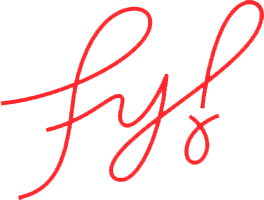
UK-based print-on-demand marketplace, I am Fy collaborates with artists to sell framed art prints, phone cases and pillow covers with their print-on-demand program. Besides this, they also sell lighting fixtures, rugs, mats and furniture. They sell the notion of “dream home decor” incredibly well.
To join, you have to send an application to the team. Someone will then get in touch with you and assist you with instructions to upload your designs to your store.
Pros of Fy:
- Extremely high positive customer reviews
- Beautiful website
- Affordable high-quality posters
- Not free to join for all
This can be both good or bad depending on how you see it. But the great thing about this is lower competition and no copycats
Cons of Fy:
- Frequent late payments
- No artist dashboard
You receive an invoice via email on the 15th of every month, listing down the designs and quantity of items you sold in the previous month. There is no information about the buyer or any way to contact them. - You need to create lifestyle mockups for all your art
- Time-consuming upload process
Fy is ideal for:
Digital Artists | Illustrators | Typography Experts
Top Selling Design Styles on Fy:
Quirky Animal Photo Manipulations | Floral Patterns | Surrealist Collages | Sassy Text
5. Printful + Etsy
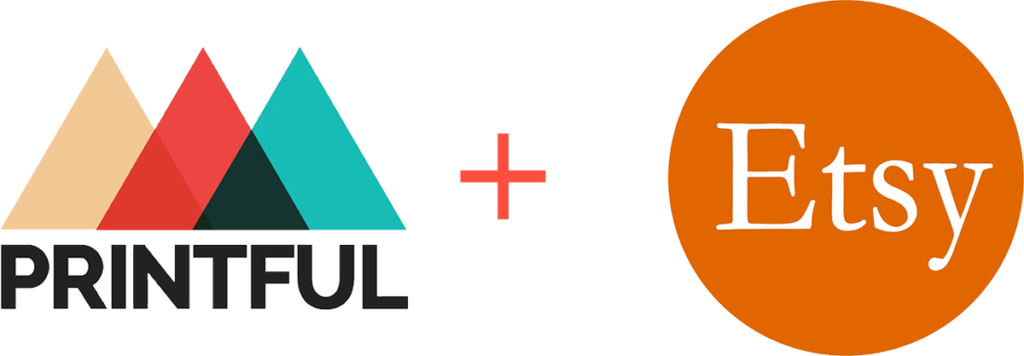
The integration of Printful with Etsy might be the most profitable print-on-demand combination for artists with a substantial social media following.
Printful is a print-on-demand platform that lets you put your designs on their broad spectrum of products. They handle the shipping and fulfilment on the backend but all the marketing and customer service has to be done by you.
Etsy has a huge audience that is looking for products on the site daily. A lot of their traffic consists of impulse shoppers that browse the site and make a purchase depending on what catches their eye.
Pros of Printful + Etsy:
- Set your prices
- Museum quality prints
- High-quality products
- Helpful A-Z tutorial videos
Cons of Printful + Etsy:
- Steep learning curve
- Takes a while to create new listings
- Outside of Etsy’s marketing, promoting your products largely depends on you
- Customer Service / Returns are handled by you
Print-On-Demand Myths
- “All I have to do is upload designs on all print-on-demand websites, and money will come rolling in.”
This statement couldn’t be further from the truth. While technically, print-on-demand IS a “passive” income stream, if you want to make substantial money from it, you need to treat the whole process as a business. It involves researching, posting, and promoting non-stop.
2. “I can steal trending artworks, upload them to my profile to sell products”.
An absolute no-no. Not only is it morally unethical to steal, but it can also get you in lawful trouble, costing you money in legal expenses. As someone on the other side constantly dealing with people stealing my artwork, I have a legal team that is well-versed in taking down infringing designs and shutting stores down. Create and sell original artwork only.
3. “I can make fan art and sell it without any problem”
Most POD websites will suspend your profile for infringing trademarks or copyrights. You could have just made a simple mistake like using the word “Disney” in the name of the title of an illustration inspired by the animation giant, or a big slip up like selling a zombie mickey mouse design.
Some sites routinely run official partnerships with movies and brands where you can submit your fan art to be sold. This is an exception. If, and only if, the artwork you submitted gets approved for that collaboration, will you be allowed to sell it.
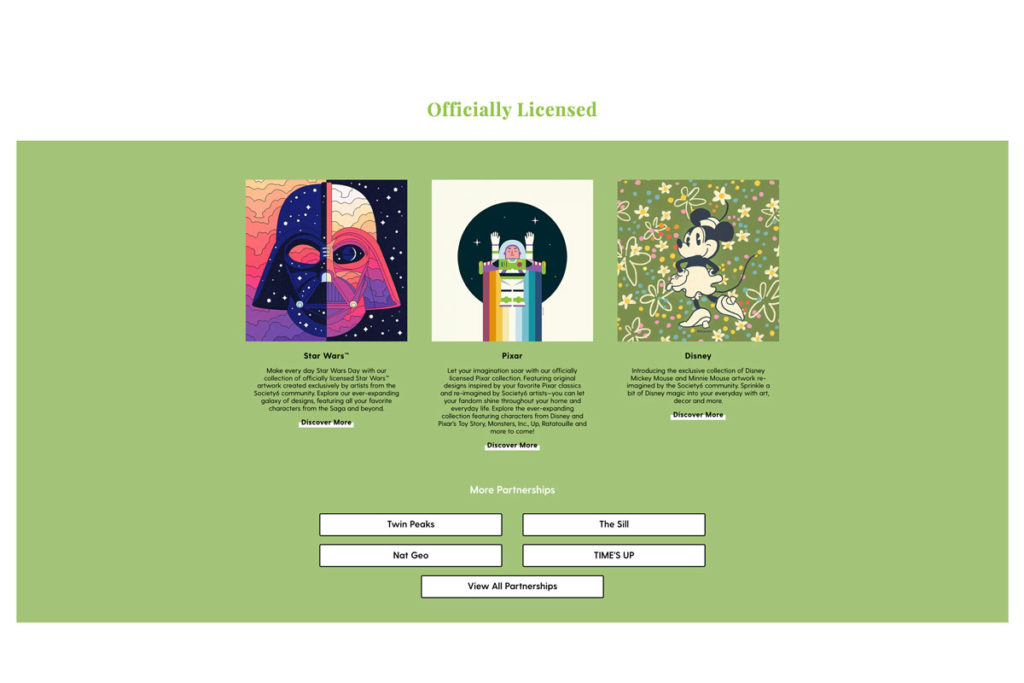
Types of Best-Selling Print-on-Demand Artworks
1. Evergreen Design
These are forever trending searches such as funny quotes, feminist sayings, watercolour floral prints, cheetah patterns and colourful gradients. Look up what’s currently trending and make better, more creative designs around similar concepts
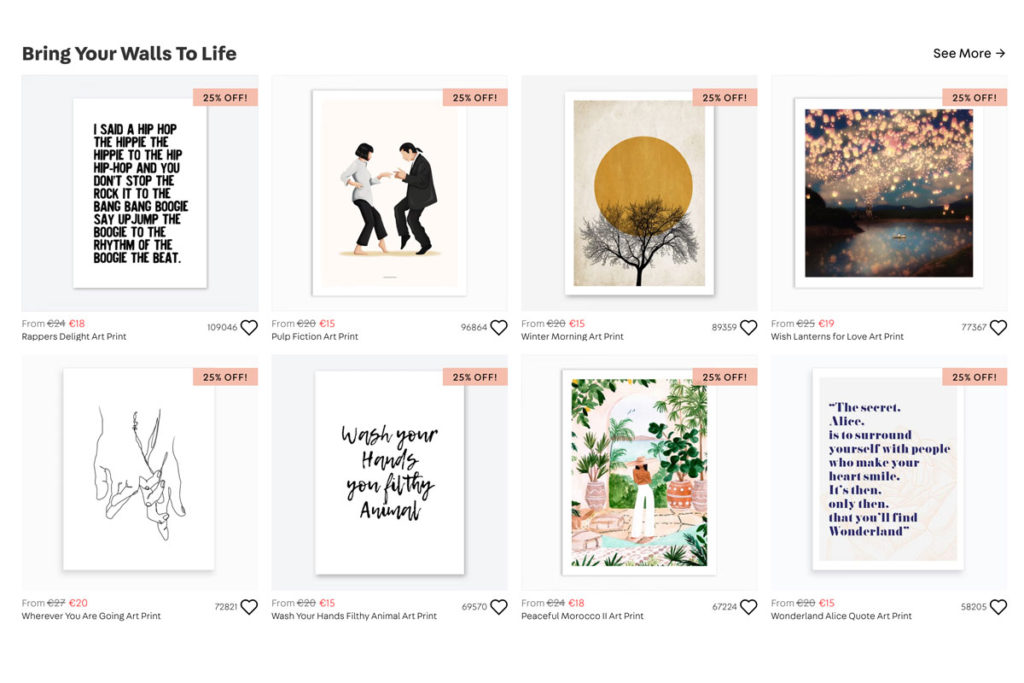
2. Trending Pieces
For this method to work, you have to be an expert at search engine research and get on the trends as soon as they start rising. The designs you put up today will take a while to appear in the results.
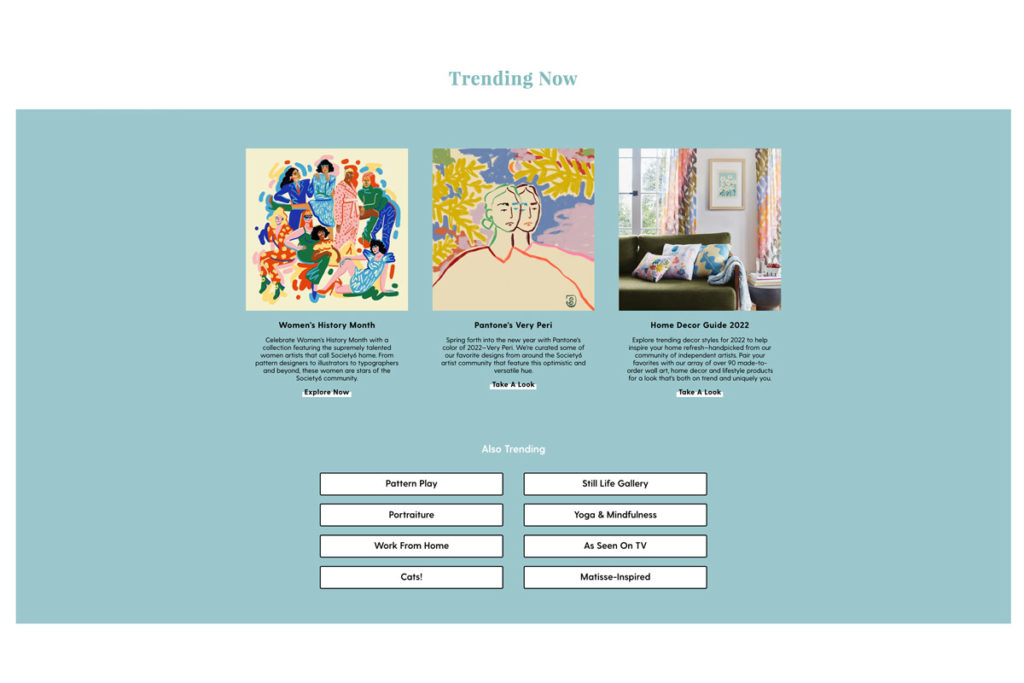
3. Niche Design Collections
Become an expert in one or several related niches. For Instance: If you have more than a hundred well-designed artworks of cactus in a desert with a beautiful sunset, you will trend for at least a couple of those artworks in the search results. Buyers will spot these designs, and those who like the concept will look through your store to purchase similar art.
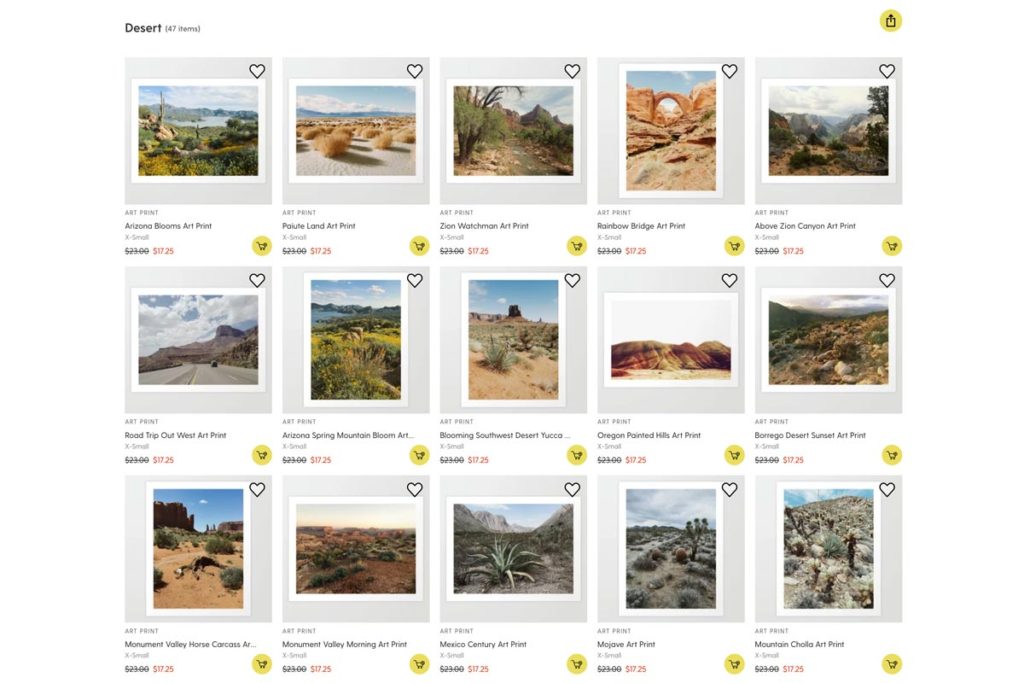
The 80/20 rule
The 80/20 rule is the Pareto principle which claims typically 80% of outcomes come from 20% of causes. I have found this rule to be spot on in the print-on-demand world!
Each of my stores has 100 or so artworks listed. Of these, 20 are responsible for most of my sales. Does that mean that the other 80 are bad? Of course not! Just that, for some reason, people are leaning more towards the 20 that sell constantly.
What’s amusing is that the 20 best-selling pieces differ from website to website. Depending on the audience and the POD marketplace’s advertising strategy, what sells like hot cakes on Redbubble, in contrast, could make you 0$ on Society6.
I believe in quality vs quantity, and if you consistently create fantastic high-quality artworks, chances are most of them won’t become bestsellers. But, the ones that do will make you a regular passive income.
Having said that, there are some successful sellers with 3000 designs listed. This is another strategy that many people apply. It could work for you if you plan on out-sourcing the design-making process and simply focus on posting and promoting.
A Step-By-Step Guide to Creating Best-Selling Print-On-Demand Artworks
Below is a ten-step guide to creating designs for print-on-demand 2 days. This is the exact method I use while designing my artwork.
The goal I set for myself is to create just 2 artworks each week or 8 in bulk when I’m on a roll. You can play around with this schedule as per the time you have on your hands.
Day 1
Step 1. Keyword & Trend Research
To begin with, look up the currently trending products on Redbubble and Society6’s homepage. Use Pinterest to see what people are obsessing with. Find the common themes in multiple websites and make a list of motifs that are hot at present.
An easy insider trick to do keyword research on Redbubble is the ABC method.
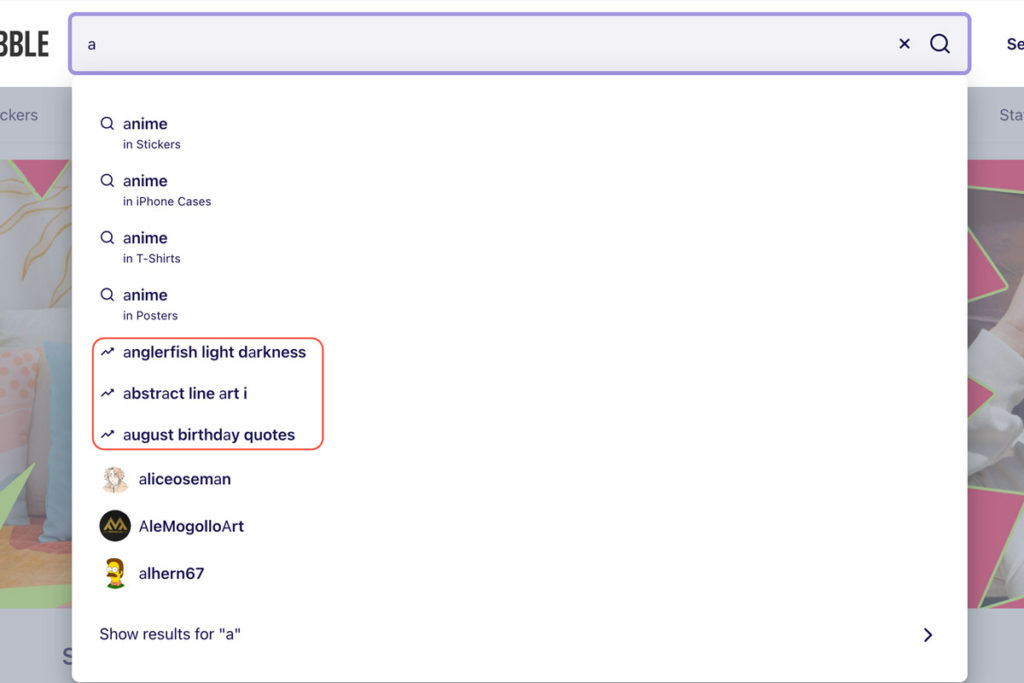
Begin by opening the incognito window and type the letter” a” in the search bar and see what appears. The words next to the zigzag upward arrow are trending words that buyers on Redbubble are currently searching for. Do this alphabet method for A-Z and list down trending words and themes that interest you or ones that are similar to your art.
Step 2.
From this list, shortlist 10 themes you like. Pick the ones that you have the skills, ideas and motivation to create a design around. Go back to the search results and check the top-selling artworks under those 10 themes.
Are you confident you can create original, better designs than those that are trending? Find at least 5 out of the 10 themes for which your answer is yes.
You can then move on to the designing stage. If you can’t, go back to research and find a trending category you can work with.
Pick 1 of these themes and begin brainstorming your method of creation.
Will you illustrate it digitally? Are you going hand-paint it and scan it? What, if any text, will you put on it?
Step 3.
Sketch out your ideas. It’s a better use of your time to come up with 3-6 different designs based on one core theme. Remember when we talked about the 80/20 principle? Your least favourite of those 3 designs may go viral and become your best seller. It’s tough to predict your customer’s choices.
That’s all for the first day. Sleep on the idea, visualize it before bed and get to the rest of the steps the next day.
Day 2
Step 4.
Think of your idea again. Do you still love it? How fast can you make 3 distinctively different concepts of it? Spend the rest of your day designing/painting them. If you’re creating digital artworks, make high-resolution files at 300dpi and at least 5000px X 9500px so that it fits on most products.
Step 5.
Pick your favourite concept of the 3 and quickly place it on mock-ups and see how it looks on t-shirts, art prints and stickers. Alternatively, you can decide at this stage if your artwork is only meant to be on specific products and make artwork files accordingly.
For photographers, scale your artwork to the largest possible size and view it at 100% on photoshop/lightroom. Make sure that the details still stay. The last thing you want is to blow up your art to fit a tapestry and have a customer receive a blurry, unusable mess.
Step 6.
Save your final artwork in three different sizes; small, medium & large. Small is the original artwork size, Medium is slightly bigger and Large is the biggest possible dimensions that you can resize your artwork to without causing pixelation.
Begin Uploading
Step 7.
Open a new browser window and launch your print-on-demand profiles on multiple websites in different tabs.
One by one, upload the small size of your art. Websites like Society6 allow you to add multiple files of the same artwork. On such sites, upload all three. This way, the app automatically uses the right size for each product’s requirements.
Step 8.
Check how the art fits on all the products. Ideally, aim for at least 80% of products being enabled for your artwork. For the disabled products, remove the design and upload the medium version. If some products stay disabled, edit those specific ones and replace the medium with the large file size.
We do this cause, more often than not, the original (small) version of our art is the least compressed version. Any resizing creates tiny to massive changes in your artwork’s resolution, which, whenever possible, we would like to avoid.
Optimize Your Listing for SEO
Step 9.
Add in your title, description & tags. Don’t leave anything blank. It’s super-duper necessary for you to add trending keywords and their synonyms to all of these places. Don’t stuff them incoherently, but use them to vibrantly describe your artwork.
For example, if you’ve designed artwork with a punk-rock dinosaur whom you’ve named Roxy, don’t put the listing title as just Roxy. Title it something like “Pink Punk Rockstar Dinosaur”.
Use tags like dinosaur, tyrannosaurus, edgy, punk-rock, rock music, rock and roll, funny animal. Describe the art style and the medium of the artwork.
Don’t put Disney or Jurrasic Park as that would be trademark infringement. If it’s a retro-inspired piece, you can put words like retro, vintage, the 80s, hipster — catch my drift?
Step 10.
Publish & promote! Don’t spam your social media followers by sharing links to the same artwork posted on multiple platforms. Instead, share just one store first, and sprinkle links to your other stores over the next few days.
Instagram and Pinterest work beautifully well for marketing your print-on-demand products.
The hard part is over! Pat yourself on the back. This doesn’t mean that money will begin rolling in as soon as you press publish. If your designs are high-quality trending pieces, the money will eventually come. Instead of waiting, upload the other 2 concepts you created and then go back to designing. Repeat the process for the remaining 4 themes you picked in step 2.
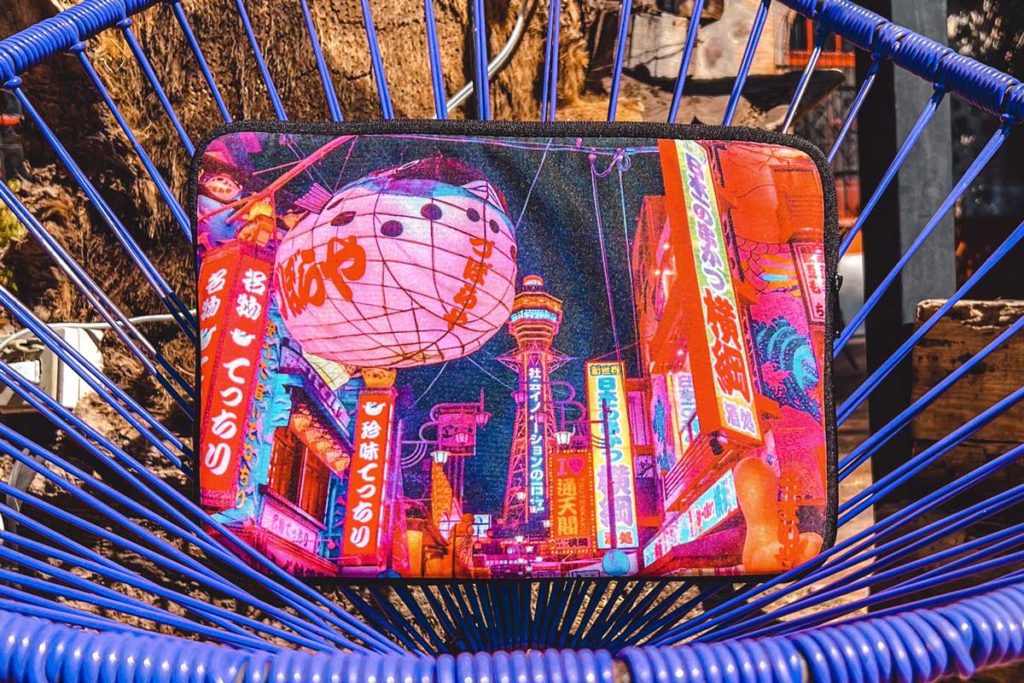
Pro Tips to Sell More With Print-On-Demand:
- Aim to enable all the products without losing quality and manually adjust the design on every item. Make sure that the best part of your artwork is visible. Also, keep in mind the locations of margins and cutmarks to prevent your design from being awkwardly cut off in production.
- Don’t upload more than 30 designs a day.
- All the Print-On-Demand website have their own rules. Some consider 30+ uploads in one sitting as an act of spamming. Your account could get terminated for doing this often.
- The second reason you shouldn’t do this is cause when you upload in bulk, it’s more likely that you will stop paying careful attention to the keywords, descriptions and artwork guidelines. Without excellent SEO, your artworks will get lost in the sea of new uploads.
- Wherever possible, avoid PayPal and use Payoneer instead. Paypal doesn’t have the best conversion rates, and you will lose a big chunk of your profit in the transfers. With Payoneer’s global banks, you will only pay 2% in transfer fees.
Make Profits with Print-on-Demand in 2022
Print-on-demand has proven to be a great side hustle for creative people looking to make extra money. For some, it’s allowed them to quit their full-time job! Others like me use the profits from their print-on-demand business to travel the world. How are you going to use the extra dough you earn from your POD store?
LIKE THIS POST? PIN IT!
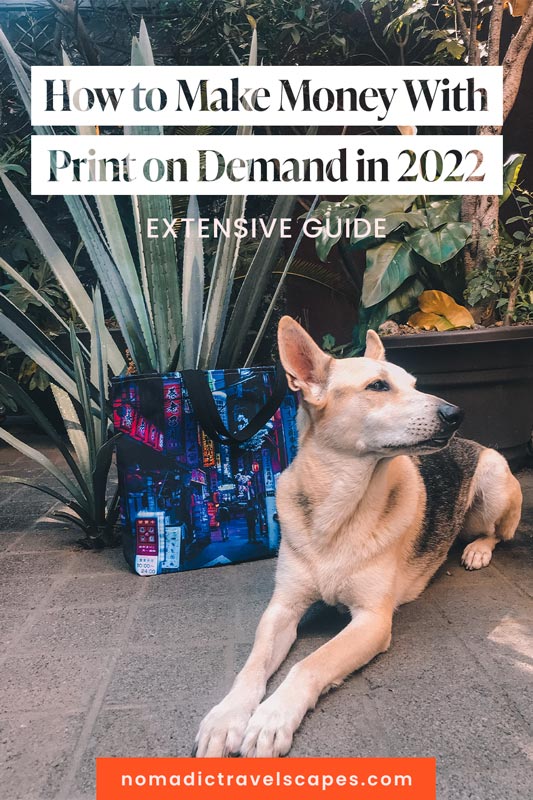


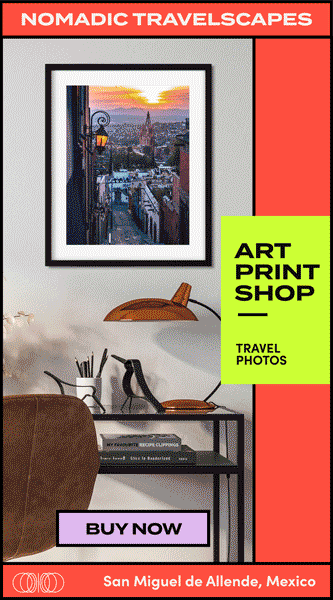

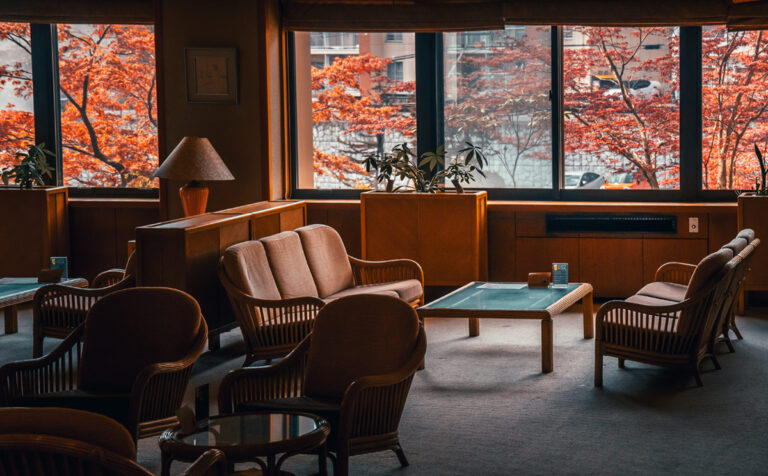






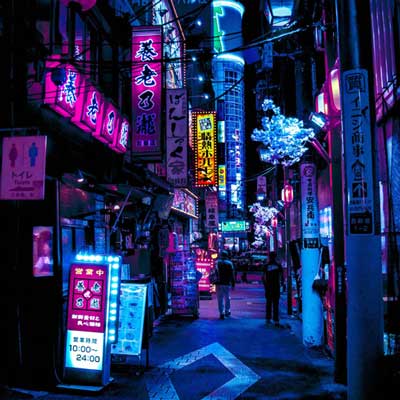
One Response
Great article. You suggest Society6, but I don’t know how any artist can actually make money. I sold prints for $16 each there, and I wasn’t even paid $1 per print. I would not recommend that service. They keep everything. Its basically a scam.